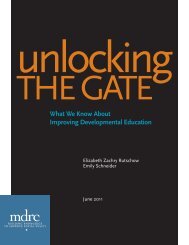Preparing High School Students for College - ERIC - U.S. ...
Preparing High School Students for College - ERIC - U.S. ...
Preparing High School Students for College - ERIC - U.S. ...
- No tags were found...
You also want an ePaper? Increase the reach of your titles
YUMPU automatically turns print PDFs into web optimized ePapers that Google loves.
Key Characteristics of State and Local Program ModelsAs the federal programs follow a fairly uni<strong>for</strong>m model and are well described inprevious reports (e.g., Constantine et al., 2006; Seftor, Mamun, & Schirm, 2009; Snipes,Holton, Doolittle, & Sztejnberg, 2006), we focus here on state and local program models inTexas. The 37 state and local programs identified in the scan had the followingcharacteristics:The majority of programs had no admissions requirements aside fromresidence in a school or community college district. However, 30 percent(n = 11) did have an entry requirement. Requirements ranged from prioracademic attainment to ethnic group membership (e.g., Hispanic orNative American).Nineteen percent (n = 7) targeted high school seniors only; 22 percent(n = 8) targeted seniors and juniors; and 49 percent (n = 18) served theentire high school population. 6Nineteen percent (n = 7) were held only during the summer, 68 percent(n = 25) were held only during the academic year, and 14 percent (n = 5)operated year-round.We had the opportunity to observe a range of programs and initiatives during oursite visits, including examples of a number of the program types identified in the scan. 7 Afull description of the programs visited is included in Appendix B. Selected programs aredescribed below, organized according to their primary area of focus. All programs wereoffered through a partnership between a high school and a college.Academic-Focused ProgramsAcross the programs visited in the Houston and Dallas–Fort Worth areas, those thatfocused primarily on academic subjects (most often reading, writing, and mathematics)were likely to engage with smaller groups of students who were at risk of placing intodevelopmental education in college. While their primary goal was to provide academiccontent, these programs often included instruction on college knowledge as well, and somefocused on strengthening academic skills, such as study skills and time management. Theacademic-focused programs were generally intense and relatively short (e.g., summer6 There were four programs (11 percent of the sample) <strong>for</strong> which we could not determine whichgrades were served. All four of these were GO Centers.7 See Appendix B <strong>for</strong> in<strong>for</strong>mation on the programs visited.16





